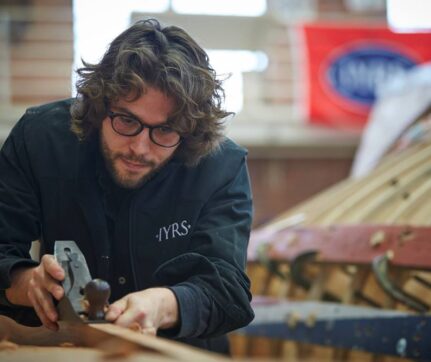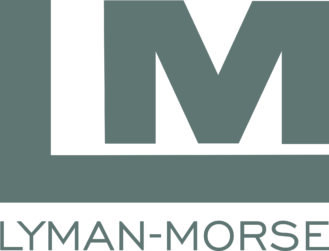By Madeline Gill
In the midst of today’s fast-paced society that so covets innovation and advancement in manufacturing, the International Yacht Restoration School (IYRS) has recognized the value in slowing down and taking the time to really learn from the past. Their signature Boatbuilding & Restoration course spans 20 months and includes both classroom and practical work. From their first days spent behind antiquated drafting tables, to their last ones spent commissioning classic yachts, students are immersed in a bona fide tribute to the past.
During the first year of the program, each aspiring boatbuilder is armed with the vocabulary, toolkit, and skill set required to master the craft. During their second year, they are put to the test. Students are assigned to small groups and given one of two tasks: restore a classic yacht or build a complete replica of one. Providing instruction, supervision, and assistance throughout this process is a self-proclaimed anachronism, Warren Barker. Barker has studied and practiced the art of traditional wooden boatbuilding for decades longer than his 14-year tenure with IYRS. Over the years, he has entertained the idea of modernization and dabbled with some more contemporary techniques, but the allure of the classic yacht has always pulled him back in.
The historic and aesthetic appeal of the century-old designs are what keep Barker and his students captivated. Following each curve detailed in the original drawings is vital in manufacturing these classic yachts. However, staying true to the architect’s vision can often require some deeper research. “Photographs and written history are important in following the original build techniques,” Barker says. And, with wooden construction, it’s not just new boats that require this knowledge; a key part of the restoration process is contorting the existing hull back into its original shape through manufacturing a mold replica. Environmental factors, like temperature and humidity, can have a big impact on the boat over time.
The Class of 2018 is currently working on three Herreshoff-designed yachts - two are small powerboat replicas and the third is a Newport 15 sailboat restoration. Though the replicas consist of just a few pieces - a stem, a stern, a keel, and some ribs - as of this writing, they will be fully outfitted and ready for launch by June of next year.
The outfit, however, will include one notable difference from that of their ancestors; these boats will be sporting electric engines. The juxtaposition of the classic construction with the cutting-edge mechanical system is an important one. Surely a part of the success IYRS has enjoyed since its inception must be attributed to their unique ability to bridge the past to the present.
Taking a class that is equal parts history and skill building and creating an evolving and ever-relevant curriculum is not an easy feat, but it is one at which Barker and his colleagues truly excel. Graduates of the Boatbuilding & Restoration program can be found working on large-scale classic yacht restoration projects to utilize the boatbuilding skills they learned at IYRS; enrolling in the Composites Technology, Marine Systems, or Digital Modeling & Fabrication programs to further explore the innovation they were introduced to at IYRS; or, as Barker notes, “going off to work on a boat and travel the world” to fully commit to a love for the sea that was nurtured at IYRS.








